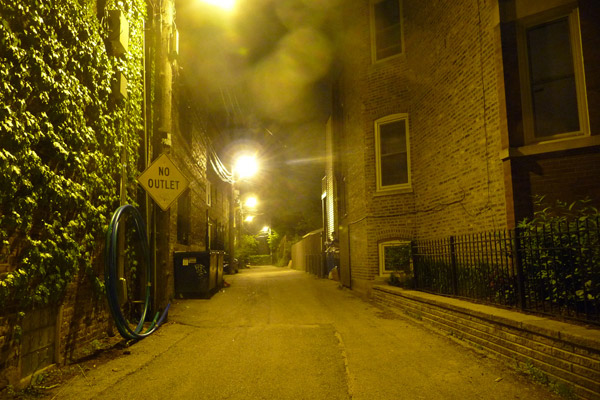
PBS NewsHour stopped by Chicago this weekend to take a look at the city's green civic infrastructure and how it's meant to get a jump on global warming. It's a broad overview, but an interesting one, with has lots of neat facts: for instance, that the effects of rising temperatures are felt much more strongly in cities than in rural areas.
My favorite fact: Chicago has 1,900 miles of alleys, the most of any city in the country (New York is too old for alleys, and Los Angeles too young). Chicago CTO John Tolva calls them the city's unsung heroes, because they allow us to run fiber-optic cable through the air, instead of underground. To answer the question Miles Doornbos poses, "How has the city been shaped by the small, nameless veins that connect its major arteries?," another obvious answer is that the city doesn't reek like New York, because the alleys allow us to hide the trash from the street.
So that's nice, too. But I can't help but wonder about its effects on urban density. Aside from garbage collection, fiber-optics, firecracker launch sites, and garage parties, 1,900 miles is a lot of space that's essentially wasted, save for perhaps reducing the need for on-street parking by allowing rear-entry garages. That's not the case in other cities, as Seattle architect Daniel Toole told The Atlantic Cities:
Are alleys something different outside the U.S.? London's famous for its mews, Paris has its arcaded passages.
Yes, in Europe and elsewhere, they are just traditional forms of urbanism, meant to carry people. In Japan, they're called roji, which basically means little street. In Melbourne, they call them laneways, which to me suggests pedestrian passage. They came about organically, with people developing parcels and setting aside space for short cuts because the blocks were so deep. The laneways became capillaries while the streets and boulevards served as the arteries.
Fellow Seattleites reclaimed the city's Nord Alley. Vancouver is building small "laneway" (i.e. alley) houses to offer affordable homes in desirable, high-rent areas, increase density, and encourage net-zero construction (not that Chicago is absent of these, as anyone who's sought a coach house can attest). But Chicagoans may just like their alleys mysterious:
It's tempting to say these pictures could have been taken anywhere, since the architectural development of a building's alley face generally isn't the subject of much stylistic intention or invention. But too many images in [Bob Thall's] "CitySpaces" are instantly recognizable as Chicago. That's because most of Chicago's downtown blocks are bisected by these alleys, inviting the curious to look while walking the city's more important streets. These narrow utilitarian niches of space aren't quite as hidden as one might expect. They quietly allow the city to work, and, with Thall's aid, they help to define the no-nonsense, can-do side of our collective civic identity.
Photograph: Rex Roof (CC by 2.0)


